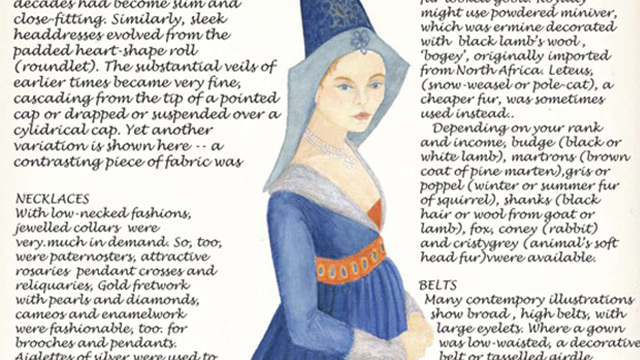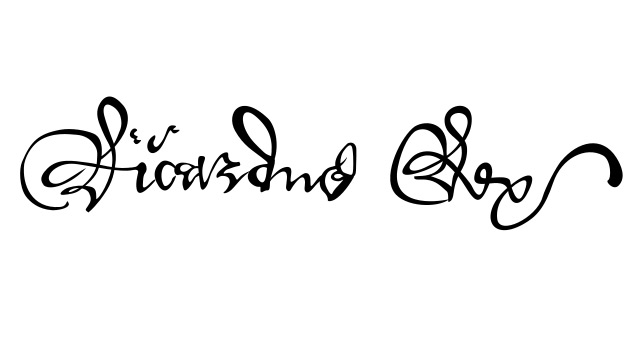How long is a piece of string? So many excellent history books abound, not to mention journal articles. Here are a few that i’ve found really helpful. There is an excellent series of biographies of English monarchs published by Methuen and Thames & Hudson. Sutton Publishing (Stroud, Gloucs.,UK) publishes many UK local histories and medieval topics. The journals of the Richard III and Jane Austen Societies contain some excellent source material.
General British and European history
(with more emphasis on medieval since that is my forté)
Anderson, Bonnie S. and Zinsser, Judith P., A History of Their Own (Penguin, 1988)
Baugh, Albert C., A History of the English Language (London: Routledge & Kegan Paul Ltd, 1957 ed)
Bayard, Tanya, transl and ed., A Medieval Home Companion (Harper Perennial, 1991)
Bradfield, N., Historical Costumes of England 1066–1956 (Harrap, 1959)
Brohaugh, William, English through the Ages (Ohio: Writer’s Digest, Books, 1998)
Danziger, Danny and Gillingham, John, 1215: The Year of Magna Carta (Coronet, 2003)
Durant, David N., Where Queen Elizabeth Slept and What the Butler Saw (New York: St Martins Press, 1997)
Evans, Joan, A History of Jewellery 1100–1870 (New York: Dover Publications Inc, 1970 ed)
Finlay, Victoria, Colour (Hodder & Stoughton, 2002)
Gies, Frances & Joseph, Cathedral, Forge and Waterwheel (HarperPerennial ed, 1995)
Goldberg, P.J.P. ed and transl., Women in England c.1275–1525 (Manchester University Press, 1995)
Lacey, Robert and Danziger, Danny, The Year 1000 (Little Brown and Company, 1999)
Landsberg, Sylvia, The Medieval Garden (British Museum Press, no date)
Muir, Richard, The English Village (Thames and Hudson Ltd, 1983 ed)
Norman Vesey, Arms and Armour (London: Weidenfeld and Nicolson, 1964)
Past Times, Lock, Stock and Barrel (Oxford 1998) provides origins of many phrases
Platt, Colin, The Castle in Medieval England and Wales (London: Chancellor Press, 1995 ed)
Rackham, Oliver, The History of the Countryside (London: J.M. Dent, 1993 ed)
Reaney, P.H., A Dictionary of English Surnames (OUP, 1997 ed)
Scholfield, John, Medieval London Houses, Yale University Press, 1995)
Stow, John, The Survey of London (Everyman Library)
Wade, Margaret Labarge, Medieval Travellers (Phoenix 1982)
Women in Medieval Life (Penguin, 1986)
Wood, Margaret, The English Medieval House (London: Bracken Books, 1983)
Tannahill, Reay, Sex in History (London: Little Brown & Co, Abacus ed., 1989)
Tannahill, Reay, Food in History (London, 1988)
Tuchman, B., A Distant Mirror (Macmillan Papermac, 1995 ed), a wonderful look at the world of the fourteenth century
Regency
Burney, Frances, Journals and Letters (Penguin, 2001)
Gadd. David, Georgian Summer: Bath in the Eighteenth Century (Wiltshire: Moonraker Press 1997)
Creevey, T., Thomas Creevey’s Papers, 1793–1838, ed. John Gore (Penguin, 1985)
Kloester, Jennifer, Georgette Heyer’s Regency World (Arrow, 2005)
Character features
Grambs, David, The Describer’s Dictionary ISBN0-393-31265-8.
Jackson, Carole, Colour Me Beautiful (Australia: Little Hills Press, 1985)
Australian sources
A browse along the Australian history reference shelves in any Australian state reference library is an excellent start for researching novels with Australian content. State libraries house archives containing personal letters and papers, old newspapers and magazines, brochures, local histories etc, whereas state archives offices hold all colonial official records: lists of convicts, musters, shipping lists etc. University libraries contain a fabulous range of Australian books and access is free, but unless you are a student or staff member, an annual borrowing card is expensive. There are a lot of records online now that can be accessed through university and state libraries.
The quality of local history books vary. A good bibliography usually indicates a professional approach, and if the book has been put out by a reputable publisher, this implies the text has had a thorough edit. Here are some Australian starters:
- Burke, K., Gold and Silver: Photographs of Australian Goldfields (Penguin Books)
- Australians: A Historical Library (Fairfax, Syme and Weldon Associates, 1987) — this reference set of ten volumes, compiled for the Bicentenary, includes a historical atlas, a gazetteer: Events and Places, a bibliography of local histories, slice histories and a dictionary of Australian history
Using the Internet
To be able to read so many old printed texts on line for free is a fabulous resource, and there are some brilliant image and map collections available. My favourite website is definitely British History Online. It contains the Victoria County Histories and some fantastic primary sources – thank you to all those hardworking people who copied all those mss for users worldwide. The UK’s National Archives now have many wills online and it is marvellous to be able to download a historical person’s will in seconds for just a modest fee. These sort of records are often useful for social details as they list people’s most valued possessions such as their best clothes, furniture and tableware.











